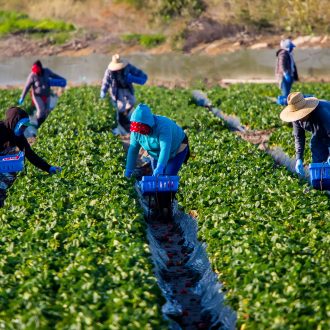“We shall strike. We shall organize boycotts. We shall demonstrate and have political campaigns. We shall pursue the revolution we have proposed. We are sons and daughters of the farm workers’ revolution, a revolution of the poor seeking bread and justice.” – Cesar Chavez
Lack of Social Benefits and Legal Protections
- Roughly one-third of the nation’s farm workers are employed on small farms that are not subject to federal law, with far higher percentages in some states. (Thompson and Wiggins, The Human Cost of Food: Farmworkers’ Lives, Labor and Advocacy.)
- The current version of the federal “Fair Labor Standards Act” specifically denies farm workers the right to overtime pay, excludes laborers on small farms from any protection (such as minimum wage and worker safety laws); and allows children as young as twelve to work in the fields. (Daniel Rothenberg, With These Hands: The Hidden World of Migrant Farmworkers Today; “A Vision for the Future of Public Policy on Migrant Farm workers.” National Council of La Raza and the Farm worker Justice Fund. Washington, D.C.)
- The National Labor Relations Act does not protect agricultural workers from retaliation against labor organizing, collective bargaining, and union membership. (“A Vision for the Future of Public Policy on Migrant Farm workers.” National Council of La Raza and the Farm worker Justice Fund.)
- Only a few states (notably California) have enacted legislation protecting the organizing, collective bargaining and unionization rights of agricultural workers. (Thompson and Wiggins, The Human Cost of Food: Farmworkers’ Lives, Labor and Advocacy.)

- According to the most recent “Findings From the National Agricultural Workers Survey,” only 28% of all farm workers reported that they would receive a payment from Workers’ Compensation, if they became sick as a result of their work. Only twenty percent of all farm workers reported that they, or someone in their family, received benefits from Unemployment Insurance within the past two years. Just one percent of all farm workers utilized disability insurance or Social Security. (Mehta, et. al; “Findings From The National Agricultural Workers Survey (NAWS) 1997-1998.” U.S. Department of Labor, March 2000.) How Migrants Help Fund U.S. Citizens’ Pensions, Mark Stevenson, Philadelphia Inquirer
- In 1997-1998, only seventeen percent of all farm workers utilized needs-based services, such as; Temporary Assistance To Needy Families (TANF), public housing, Medicaid, Food Stamps and the nutritional program known as Women, Infants and Children, or WIC. In addition, very few farm workers reported receiving support from churches, family, community organizations or friends. (Mehta, et. al; “Findings From The National Agricultural Workers Survey (NAWS) 1997-1998.” U.S. Department of Labor, March 2000.)



